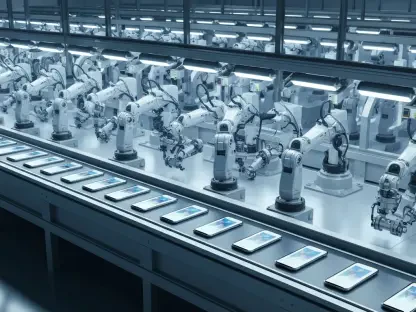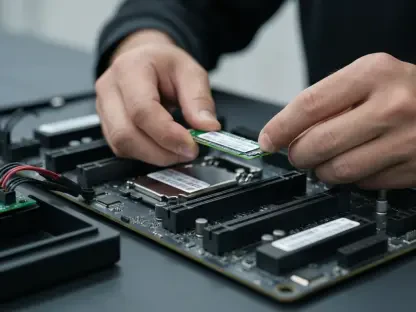The financial world is witnessing a seismic shift as the next generation of finance leaders moves away from the once-dominant allure of cryptocurrencies and sets its sights on the transformative potential of artificial intelligence (AI) and robotics. This transition is not merely a fleeting change in investment fads but a profound reorientation driven by a deeper understanding of value in the digital era. Younger investors and institutional players alike are recognizing that while crypto often represents speculative risk, AI and robotics offer tangible solutions to pressing global challenges like automation and productivity. This pivot reflects generational differences in tech adoption, a hunger for innovation with real-world impact, and a strategic focus on long-term economic growth. As the landscape evolves, it becomes clear that these emerging technologies are poised to redefine industries and reshape the future of finance in ways that speculative digital assets may not.
Generational Preferences Redefine Tech Investment
A notable divide exists between generations when it comes to embracing emerging technologies, with younger cohorts like Gen Z and Gen Alpha steering the conversation toward AI and robotics. Unlike Millennials, who still hold a significant share of cryptocurrency ownership, these digital natives view AI as an integral part of their daily routines and future professional paths. Recent surveys among U.S. interns reveal a striking trend: 96% rely on AI tools for their work, while a mere 18% have any stake in crypto. This disparity underscores a fundamental shift in trust and interest, where technologies that enhance efficiency and problem-solving take precedence over volatile digital currencies. The preference isn’t just about familiarity; it’s about envisioning a future where tech directly addresses systemic issues like labor shortages and operational inefficiencies, positioning AI and robotics as the cornerstones of innovation.
Beyond usage statistics, this generational shift also reflects a cultural redefinition of what constitutes value in the digital economy. Younger investors are less swayed by the speculative hype that once fueled crypto markets and more focused on technologies that promise measurable impact. For instance, the enthusiasm for robotics among European interns, with 69% expressing keen interest in humanoid systems, highlights a fascination with solutions that could revolutionize industries facing workforce challenges. This contrasts sharply with the declining appeal of crypto, even among Millennials who are beginning to diversify their holdings amid regulatory uncertainties. The focus on AI and robotics among the youngest generations signals a broader movement toward investments that align with practical, forward-thinking goals rather than high-risk, high-reward gambles that characterized earlier tech booms.
Institutional Capital Flows to AI and Robotics
Institutional investors are aligning with this generational shift by redirecting substantial capital toward AI and robotics, viewing them as foundational to the next wave of industrial transformation. In the second quarter of the current year, venture capital funding for crypto took a steep dive, dropping 59% to just under $2 billion, while AI investments soared to an unprecedented $47.3 billion. Robotics is also capturing attention, securing 6.7% of venture capital votes and, in some metrics, even outpacing AI. This redirection of funds isn’t merely a chase for the latest trend; it represents a calculated bet on sectors that promise scalable solutions for critical issues like supply chain automation and human-machine collaboration. The institutional belief is clear: AI and robotics are not just growth opportunities but essential pillars of future economic stability.
This massive capital inflow into AI and robotics also reflects a pragmatic approach to long-term value creation among institutional players. The focus on AI infrastructure, including hardware and computing power, alongside robotics automation, demonstrates a commitment to technologies that underpin societal and industrial progress. Unlike the speculative nature of crypto investments, which are often tied to market volatility, these sectors are seen as infrastructure plays with predictable growth trajectories. Major investors are willing to pay premium multiples for AI startups, signaling confidence in their ability to deliver sustained returns. As this trend continues, it reinforces the notion that institutional backing will likely accelerate the development and adoption of AI and robotics, further solidifying their position over crypto in the financial ecosystem.
Retail Investors Embrace Practical Technologies
Among retail investors, particularly the younger demographic, a cultural shift is evident as enthusiasm for AI and robotics overshadows interest in cryptocurrencies. This isn’t just a matter of preference but a reflection of how these technologies integrate into everyday life and address tangible challenges. For instance, the growing curiosity about humanoid robotics, with 69% of European interns expressing interest, points to a recognition of its potential to solve real-world problems like labor shortages. This stands in stark contrast to the diminishing allure of crypto, where regulatory uncertainties and price swings have led even seasoned Millennial investors to explore other avenues. The retail landscape is thus evolving to prioritize technologies that offer practical utility over speculative promise.
This trend among retail investors also highlights a broader redefinition of risk and reward in personal finance. Younger generations, having grown up with digital tools, are more inclined to invest in technologies they interact with daily, such as AI platforms that streamline workflows. The low ownership rate of crypto—only 18% among surveyed U.S. interns—suggests a cautious approach to assets perceived as unstable or detached from immediate societal needs. Instead, the focus on robotics and AI indicates a desire to back innovations that could reshape industries like manufacturing and healthcare. This shift isn’t merely about following institutional trends; it’s about a fundamental alignment with technologies that resonate with personal and professional aspirations, marking a departure from the crypto-driven fervor of previous years.
Long-Term Outlook Prioritizes Scalable Solutions
Looking toward the future, projections indicate a widening gap between the trajectories of crypto and the combined potential of AI and robotics. While some analysts remain optimistic about Bitcoin, forecasting valuations as high as $1 million by 2040 under specific macroeconomic conditions, younger investors appear hesitant to stake their financial futures on such volatile predictions. In contrast, industry reports project the deployment of over 100,000 humanoid robots by 2030, signaling a robust growth path for robotics. Similarly, the adoption of agentic AI is accelerating, with 68% of IT leaders expecting to implement these systems within the next six months. These figures suggest a consensus that AI and robotics are not speculative ventures but imminent realities with concrete applications.
The long-term outlook further emphasizes the strategic importance of AI and robotics as investments backed by both private and public sector initiatives. Unlike crypto, which often hinges on unpredictable market dynamics, these technologies are supported by sovereign strategies and energy policies aimed at fostering innovation. The rapid integration of AI into enterprise systems and the projected expansion of robotics into various sectors point to a sustained growth curve that aligns with global economic priorities. This perspective is particularly compelling for finance leaders who prioritize stability and scalability over high-stakes speculation. As these technologies continue to mature, their role in shaping industries and driving economic transformation becomes increasingly undeniable, offering a more reliable foundation for long-term capital allocation.
Strategic Investment Moves for Emerging Trends
For investors navigating this evolving financial terrain, the direction is unmistakable: focus on AI and robotics while exercising caution with crypto exposure. Opportunities in AI hardware and infrastructure are abundant, with companies like NVIDIA and AMD leading the charge in powering the next generation of computing. Similarly, robotics innovations, such as Tesla’s Optimus project, represent cutting-edge developments in automation with vast potential. For those still considering crypto, regulated ETFs offer a safer entry point to mitigate risks associated with custody and volatility. This strategic emphasis on technologies that solve real-world problems over speculative assets aligns closely with the vision of emerging finance leaders who are redefining value in the digital economy.
Balancing portfolios with diversified investments across high-growth tech sectors and defensive industries like healthcare also emerges as a prudent approach. The focus on enterprise applications of AI, through firms like IBM and Salesforce, provides another avenue for stable returns. In robotics, breakthroughs in industrial automation and humanoid systems are areas to watch closely for future growth. This diversified strategy not only mitigates the volatility associated with speculative assets but also positions investors to capitalize on the transformative impact of AI and robotics. As the financial landscape continues to shift, aligning investments with technologies that promise to redefine productivity and industrial paradigms offers a forward-thinking path to sustained success.









